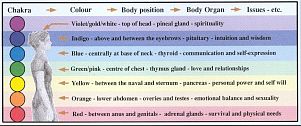|
PRIME: PHILOSOPHY,
CULTURE and RELIGION,
continued

Chakra,
an Asian cultural view, is also applied as an alternative
therapy to modify human behaviour and health. It takes
into account, various colours in order to find " inner
balance ". In simple
terms, one's prior programming or " Karma ",
that is, the challenges with which one is born (from
nature), may be mitigated with the appropriate balancing
of one‘s Chakras. (through. nurture).
|
The
word, Chakra, comes from the Sanskrit, meaning " wheel "
or " disc ",
viewed as interconnecting coloured wheels; the colour
and position of which, are designated to parts and
organs of the body, and associated with a number
of personal issues: |
|
 Chakra positions
associating various personal issues
Chakra positions
associating various personal issues
|
There
are cultural and religious differences in the way colour
may be perceived.
Colour symbolism
can be found in the iconography of many faiths. Certain
colours signify certain deities, passions, and/or ideas.
In the West ( certainly since the time of Queen Victoria ),
black
has been associated with death and in most Christian countries,
white is consistently associated with purity, virginity
and the wedding ceremony. By contrast, Taoism, a view
from the Far East, associates white with death, and in
India, bright colours such as crimson,
peach
and magenta,
are often associated with marriage. |